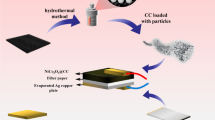Abstract
The last decade has witnessed the emergence of hydrovoltaic technology, which can harvest electricity from different forms of water movement, such as raindrops, waves, flows, moisture, and natural evaporation. In particular, the evaporation-induced hydrovoltaic effect received great attention since its discovery in 2017 due to its negative heat emission property. Nevertheless, the influence of electrode reactions in evaporation-induced power generation is not negligible due to the chemical reaction between active metal electrodes and water, which leads to “exceptional” power generation. Herein, we designed a series of experiments based on air-laid paper devices with electrodes of different activities as the top and bottom electrodes. To verify the contribution of electrodes, we compared the output performance of different electrode combinations when the device was partially-wetted and fully-wetted. The device hydrophilicity, salt concentration, and acidity or basicity of solutions were also comprehensively investigated. It is demonstrated that the chemical reaction of active metals (Zn, Cu, Ag, etc.) with different aqueous solutions can generate considerable electrical energy and significantly distort the device performance, especially for Zn electrodes with an output voltage from ~ 1.26 to ~ 1.52 V and current from ~ 1.24 to ~ 75.69 µA. To promote the long-term development of hydrovoltaic technology, we recommend use of inert electrodes in hydrovoltaic studies, such as Au and Pt, especially in water and moisture environment.

Similar content being viewed by others
References
Yin, J.; Zhou, J. X.; Fang, S. M.; Guo, W. L. Hydrovoltaic energy on the way. Joule 2020, 4, 1852–1855.
Zhang, Z. H.; Li, X. M.; Yin, J.; Xu, Y.; Fei, W. W.; Xue, M. M.; Wang, Q.; Zhou, J. X.; Guo, W. L. Emerging hydrovoltaic technology. Nat. Nanotechnol. 2018, 13, 1109–1119.
Shen, D. Z.; Duley, W. W.; Peng, P.; Xiao, M.; Feng, J. Y.; Liu, L.; Zou, G. S.; Zhou, Y. N. Moisture-enabled electricity generation: From physics and materials to self-powered applications. Adv. Mater. 2020, 32, 2003722.
Xue, G. B.; Xu, Y.; Ding, T. P.; Li, J.; Yin, J.; Fei, W. W.; Cao, Y. Z.; Yu, J.; Yuan, L. Y.; Gong, L. et al. Water-evaporation-induced electricity with nanostructured carbon materials. Nat. Nanotechnol. 2017, 12, 317–321.
Ding, T. P.; Liu, K.; Li, J.; Xue, G. B.; Chen, Q.; Huang, L.; Hu, B.; Zhou, J. All-printed porous carbon film for electricity generation from evaporation-driven water flow. Add. Funct. Mater. 2017, 27, 1700551.
Wang, X. F.; Lin, F. R.; Wang, X.; Fang, S. M.; Tan, J.; Chu, W. C.; Rong, R.; Yin, J.; Zhang, Z. H.; Liu, Y. P. et al. Hydrovoltaic technology: From mechanism to applications. Chem. Soc. Red. 2022, 51, 4902–4927.
Zheng, C. X.; Chu, W. C.; Fang, S. M.; Tan, J.; Wang, X. F.; Guo, W. L. Materials for evaporation-driven hydrovoltaic technology. Int. Mater. 2022, 1, 449–470.
Xu, W. H.; Zheng, H. X.; Liu, Y.; Zhou, X. F.; Zhang, C.; Song, Y. X.; Deng, X.; Leung, M.; Yang, Z. B.; Xu, R. X. et al. A droplet-based electricity generator with high instantaneous power density. Nature 2020, 578, 392–396.
Fang, S. M.; Li, J. D.; Xu, Y.; Shen, C.; Guo, W. L. Evaporating potential. Joule 2022, 6, 690–701.
Cheng, F. Y.; Chen, J. Metal-air batteries: From oxygen reduction electrochemistry to cathode catalysts. Chem. Soc. Red. 2012, 41, 2172–2192.
Li, L. H.; Gao, S. W.; Hao, M. M.; Yang, X. Q.; Feng, S. J.; Li, L. L.; Wang, S. Q.; Xiong, Z. P.; Sun, F. Q.; Li, Y. et al. A novel, flexible dual-mode power generator adapted for wide dynamic range of the aqueous salinity. Nano Energy 2021, 85, 105970.
Zhang, K.; Cai, L.; Nilghaz, A.; Chen, G. X.; Wan, X. F.; Tian, J. F. Enhancing output performance of surface-modified wood sponge-carbon black ink hygroelectric generator via moisture-triggered galvanic cell. Nano Energy 2022, 98, 107288.
Tabrizizadeh, T.; She, Z.; Stamplecoskie, K.; Liu, G. J. Empowerment of water-evaporation-induced electric generators via the use of metal electrodes. ACS Omega 2022, 7, 28275–28283.
Li, L. H.; Hao, M. M.; Yang, X. Q. Sun, F. Q.; Bai, Y. Y.; Ding, H. Y.; Wang, S. Q.; Zhang, T. Sustainable and flexible hydrovoltaic power generator for wearable sensing electronics. Nano Energy 2020, 72, 104663.
Li, Y.; Zhang, L. B.; Li, J.; Lian, X. X.; Zhu, J. W. Crystallization characteristics of zinc oxide under electric field and Raman spectrum analysis of polarized products. Acta Phys. Sin. 2019, 68, 070701.
Cao, C.; Xie, X. X.; Zeng, Y. M.; Shi, S. H.; Wang, G. Z.; Yang, L.; Wang, C. Z.; Lin, S. W. Highly efficient and stable p-type ZnO nanowires with piezotronic effect for photoelectrochemical water splitting. Nano Energy 2019, 61, 550–558.
Acknowledgements
This work was supported by the National and Jiangsu Province NSF (Nos. T2293691 and BK20212008) of China, National Key Research and Development Program of China (No. 2019YFA0705400), the Research Fund of State Key Laboratory of Mechanics and Control of Mechanical Structures (No. MCMS-I-0422K01), the Fundamental Research Funds for the Central Universities (No. NJ2022002), and the Fund of Prospective Layout of Scientific Research for NUAA (Nanjing University of Aeronautics and Astronautics).
Author information
Authors and Affiliations
Corresponding author
Electronic Supplementary Material
Rights and permissions
About this article
Cite this article
Zheng, C., Fang, S., Chu, W. et al. Role of electrodes in study of hydrovoltaic effects. Nano Res. 16, 11320–11325 (2023). https://doi.org/10.1007/s12274-023-5881-x
Received:
Revised:
Accepted:
Published:
Issue Date:
DOI: https://doi.org/10.1007/s12274-023-5881-x




